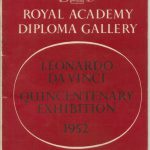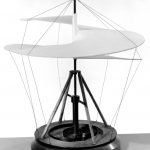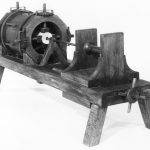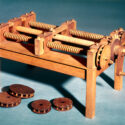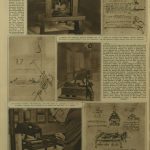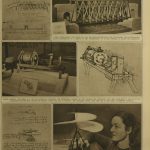The Science Museum and the Leonardo da Vinci Quincentenary Exhibition of 1952
Article DOI: https://dx.doi.org/10.15180/150403
Abstract
A large and successful exhibition to mark the 500th anniversary of the birth of Leonardo da Vinci was held at the Royal Academy, Burlington House, London, in 1952. It was an important event for the public appreciation of Leonardo’s genius. The proposal for the exhibition had come from the Science Museum, whose staff arranged a ‘scientific section’ of the exhibition, providing and displaying photographs and models. The story of these early models is particularly interesting in the light of the subsequent expansion in the use of mechanical models and animations to interpret and present Leonardo’s work. Questions that surrounded their introduction are accentuated by the ubiquity of models today. Some of the 1952 models will be displayed at the Science Museum in 2016, alongside an exhibition of a large group of ‘historical models’ first displayed in Milan in 1953. The occasion should provoke some thoughtful consideration of the current influence of this tool for research and display.
Keywords
Leonardo models, Royal Academy, Science Museum
Introduction
https://dx.doi.org/10.15180/In 1952 a successful exhibition was mounted at the Royal Academy in London to mark the 500th anniversary of the birth of Leonardo da Vinci. There were many indicators of its success, among them the decision to extend the run to accommodate over 200,000 visitors in six months and a healthy income for the Academy from admission charges. In the modest catalogue, devoid of illustrations, the Academy’s President, Sir Gerald Kelly, opened his preface with a generous and, surprising as it may seem, entirely accurate acknowledgement that:
It was the Science Museum which first proposed that an Exhibition should be held to celebrate the Quincentenary of the birth of Leonardo da Vinci.
Royal Academy, 1952, p iii
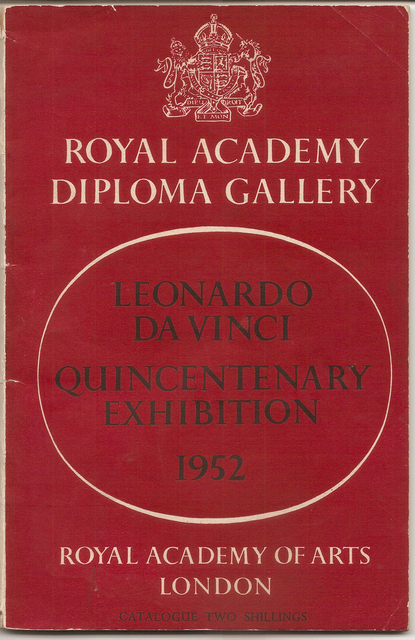
Today Leonardo is one of the most popular subjects for public exhibitions. We are accustomed to high-profile examples, presented as ambitious revelations of the mind and achievements of the greatest genius. The National Gallery in London offered its Leonardo show of 2011–12 as an ‘unprecedented exhibition – the first of its kind anywhere in the world’,[1] and the 2015 exhibition in the Palazzo Reale in Milan is, according to the official website, ‘the most important ever to be organized in Italy’.[2] In a crowded market organisers may look for niche novelty: a 2012 exhibition in Buckingham Palace, for example, was ‘the largest ever of Leonardo da Vinci’s studies of the human body’.[3] ‘Da Vinci – The Genius’, an exhibition of reproductions and animations at three venues in 2015 is ‘the world’s most comprehensive touring Leonardo da Vinci exhibition’.[4]
At the same time, touring shows can be tailored to quite modest venues, so that, for a fee, Leonardo exhibitions can appear in many places, which are not confined to museums. Sets of models of machines and other devices based on Leonardo’s drawings play an important part in this exhibition trade. One reason certainly is the appeal of the models themselves, alongside the ingenuity evident in the designs. Another could be that there are no original Leonardo models, or even any evidence that he ever made one, caused one to be made or perhaps only rarely imagined that his drawings were patterns for the making of models or of full-scale machines (for one exception, see Kemp, 2006, p 63). So looking at a model in an exhibition is not a substitute for looking at the real thing. No ‘real things’ exist to be seen and the model is always an interpretation, presenting the work of the builder as well as that of Leonardo. Given his popular repute, the role that machine models play in shaping this reputation, and the cultural significance of large monographic exhibitions of loaned material, at the Royal Academy and elsewhere, the history of an early instance of such a conjunction is worth our attention.
The ambition of the present article is limited to drawing out a relatively unknown episode in the growth of Leonardo’s public repute, but this local story is part of a growing European appreciation in the early twentieth century of Leonardo’s activities beyond painting. One of the characters in the local story, Ivor B Hart, had published a book in 1925 on what he called Leonardo’s ‘amazing scientific achievements’, which he presented as an effort to compensate for Britain’s absence from a project of ‘Continental’ scholarship (Hart, 1925, preface), located principally in France and Germany. His central concern was aeronautics, but this had to be related to Leonardo’s approach to mechanics in general. In a similar way, the exhibition at the Royal Academy was an opportunity, relished by its President, for Britain to join an international enterprise that already involved Milan, Florence, Venice, Vinci, Rome, Dallas and Los Angeles.[5]
An exhibition proposal
https://dx.doi.org/10.15180/150403/002The main file on the exhibition preserved at the Science Museum opens with the initial proposal, handwritten on Board of Education foolscap minute paper by one of the more junior curators, Keith Reginald Gilbert (an Assistant Keeper) to his Keeper, William O’Dea, and dated 9 August 1949:
1952 is the quincentenary of the birth of Leonardo da Vinci, and I think that consideration might be given to the possibility of celebrating this important anniversary by a special exhibition.[6]
Gilbert had joined the Museum only the previous year but already his plan distinguished three sections that would survive the entire process of making the exhibition: original drawings in British collections; photographic copies of those held elsewhere; and models based on the drawings. The Science Museum had done nothing so ambitious since the War and we might think that Gilbert was displaying the naïve enthusiasm of a newcomer. Even so, O’Dea lost no time in asking the Director, Herman Shaw, for permission to go ahead with the single model Gilbert had proposed for his own area of textile mechanics, to be made in the Museum’s workshops. This was Leonardo’s spinning machine, which, as it happens, was never made. Furthermore, O’Dea liked the idea of a more ambitious exhibition and thought it should be discussed among the other relevant Keepers.
The Director considered that, rather than commissioning a single model, the possibility of a ‘Special Exhibition’, a term he placed in inverted commas because it was clearly not an everyday one, should be explored. Accordingly, by 8 September Gilbert had prepared an extensive proposal, now typewritten, where he outlined Leonardo’s achievements in applied mechanics, compiled a short bibliography and a list of manuscripts in Britain, and described the ‘splendid exhibition in Milan in 1939’. This, he reported, had included about 120 models and he attached copies of the exhibition guide and the catalogue. Gilbert made the point that the exact date of Leonardo’s birth, 15 April 1452, had been settled only in 1939. This would be the first time a Leonardo anniversary could be celebrated with confidence.[7]
The very large Leonardo exhibition at the Palazzo dell’Arte in Milan in 1939 contained two hundred models based on Leonardo’s drawings. The models had been made at the request of Benito Mussolini. The Milan models became known in Britain through pictures in The Illustrated London News (Illustrated London News, 1939). The Liberal peer Herbert Samuel suggested to Ernest Mackintosh, then Director of the Science Museum, that the exhibition might come to London, but that was considered impossibly expensive.[8] The models were displayed in New York in 1940 but in 1942 were lost at sea, it would seem following their exhibition in Japan and, although the record is sketchy, as a result of a wartime engagement (Landrus, 2013, pp 323–5). Another famous early set was commissioned by the Los Angeles Country Museum from the Italian engineer, Roberto Guatelli, who became a specialist in Leonardo models. It was displayed in Los Angeles in 1949, then went on tour and was purchased in 1951 by IBM, who commissioned further models from Guatelli and organised travelling exhibitions (Landrus, 2013, pp 323–5; Moon, 2007, pp 200–03).
As O’Dea passed Gilbert’s paper on to the Director, it was clear that his enthusiasm for the exhibition project had increased, though he recognised that Leonardo’s ideas had not been directly influential and he speculated on why this might have been: ‘Unlike Galileo, Leonardo seems not to have been particularly aggressive in the face of prejudice against the developments he probably regarded as sound but dangerous to his safety if he pushed them too diligently’.[9] What O’Dea can have imagined was dangerous about Leonardo’s mechanical ideas, his consideration of fossils notwithstanding, is far from clear, but the remark reflects the prevailing emphasis at the Museum on what were seen as progressive contributions to the making of modern science. A genius he may have been, but had Leonardo played an effective part in that history?
What emerged from O’Dea’s discussion with the Director was nothing more decisive than an instruction to Gilbert to circulate the proposal around senior officers in other departments. For the most part they were not enthusiastic – John Chaldecott, Arthur Stowers, William Church, Fredrick Skinner and Henry Calvert demurred in turn for one reason or another: display space was limited; workshop staff were occupied; Leonardo was irrelevant to the development of science; and so on.
A completely different tone was struck by Frank Greenaway,[10] who in a firm hand dashed off the retort that his colleagues had ‘missed an essential point’: Leonardo, as he put it, would be ‘News’ in 1952. Here was an opportunity that others would be keen to grasp:
The artistic and literary worlds will make much of him…to look beyond the limits of the object in hand, they will use the study of Leonardo’s own achievement to illustrate wider aspects of the period and general truths of historical development. … If, of the other hand, the imagination of the Museum is limited to the practicability of moving object X from case Y to case Z we had better keep out of the arena.[11]
With that challenge on the file, F A B Ward and Philip Sumner in their turn could hardly do other than give Gilbert some qualified support. Greenaway had tried to change the historical agenda. The other keepers saw the Museum’s mission as presenting the development and the content of science today; whatever his individual accomplishments, if Leonardo had not contributed to that historical progression, he was scarcely relevant. Greenaway, on the other hand, took a more historical view. Leonardo’s place in the Renaissance was of interest in itself and did not depend on present-day science, while his anniversary was a signal opportunity for cultural impact. His suggestion was for an exhibition on ‘Leonardo and the Science of his Times’.
Gilbert tried again in October 1950. He had a new Keeper in Arthur Stowers and a new Director in Frank Sherwood Taylor. His prospects must have looked brighter: Sherwood Taylor was a historian and intellectual, with a mission to humanise the sciences after two world wars had made the dangers of a narrow, technical, unthinking, dehumanised focus on science all too evident (Simcock, 1987; Greenaway, 2004). Leonardo might well be an attractive subject, bridging the humanities and the sciences. In the previous round Stowers had judged that Leonardo had had ‘no influence on the development of Motive Power’ and, more tellingly, had raised a doubt about the value and legitimacy of making models from his drawings: ‘I am doubtful whether many of Leonardo’s devices were actually used in practice, and many sketches are not sufficiently clear to make models from them.’ Nonetheless, Gilbert began to revive his scheme by preparing for Stowers an accurate summary of the file so far, which he is unlikely to have done without being asked.
Gilbert admits that, having consulted eleven officers responsible for collections in subjects of interest to Leonardo, ‘In many cases the response was not enthusiastic because L da V’s stature as a scientist and inventor has only been appreciated in modern times and it cannot be shown that his ideas had much influence on the development of science and technology’.[12] So, Greenaway’s alternative historiography had not prevailed. Gilbert goes on to subsume Stowers’s doubt about the legitimacy of making models into the same question: ‘Consequently it is thought that the effort involved in constructing models of machines, which have never in fact existed outside L da V’s M.S.S., would be better employed in some other development of the collections.’ In other words, if no machines had been made, if they had got no further than drawings in private manuscripts, what justification was there for committing Science Museum resources to their explication through the making of models? We might assume this was not Gilbert’s attitude, but it was a fair summary of the consensus among his colleagues.
At least Donovan Chilton had offered a stratagem to cover one of the dangers of making models. He thought that full-size constructions, such as those in the Italian exhibition, might give visitors the wrong impression that the machines had in fact been made in Leonardo’s time and here were reproductions of them. Any models constructed should be small, ‘so that it is clear that they are only realisations of the notebook sketches’. This would also help with the other issue raised by Stowers, since ‘small scale models would also avoid the difficulty of representing detail which is conjectural’.
Gilbert found himself facing the possibility of, at best, rather a small exhibition, which he thought would be inappropriate to the range of Leonardo’s work and to the whole idea of celebrating the anniversary in the first place. It was clear that the departments were not going to divert sufficient resources to realise an exhibition to match the occasion. His rather surprising answer was to propose a much larger exhibition, hosted at the Science Museum but organised in collaboration with other bodies: his shrinking project would re-emerge as a contribution to something much more ambitious. The first step would be to approach other institutions, with a view to setting up ‘a representative committee to organise the exhibition’.
Stowers passed this suggestion to Sherwood Taylor, with Gilbert’s list of possible collaborators, explaining the muted interest in a quincentenary exhibition from Leonardo’s marginal influence on the physical sciences and adding the telling remark that he did not appear in the index of ‘your book’, The World of Science. The absence of empathy between Sherwood Taylor and his senior curatorial staff is well known and this little remark from Stowers exemplifies his problem. His colleagues seemed oblivious to distinctions that would have been obvious to Sherwood Taylor. The World of Science was a general science textbook and was not concerned with history. The only names in the index came with eponymous phenomena, such as ‘Heaviside-Kennelly layer’ or ‘Newton’s rings’. On the other hand, Sherwood Taylor’s A short history of science, published in 1939, had several references to Leonardo, including a short but positive section specifically devoted to him and a reproduced drawing.
Sherwood Taylor agreed to the suggestion of writing to possible collaborators and Gilbert and Stowers prepared a draft letter, choosing the British Museum as the first recipient and asking whether there were any plans for an exhibition.[13] The Science Museum could offer a few models, a selection of photographs, and staff assistance with an appropriate section of a general exhibition.
The Royal Academy
https://dx.doi.org/10.15180/150403/003The Director of the British Museum, Sir Thomas Kendrick, advised approaching Sir Gerald Kelly, the energetic President of the Royal Academy, an institution that had not figured on Gilbert’s list.[14] Armed with a memo prepared by Gilbert, Sherwood Taylor met Kelly on 16 February 1951 and from then on the project steamed ahead. Kelly proposed using the Diploma Galleries at Burlington House[15] during March and April 1952 and began immediately to draw up lists of lecturers and potential members of the committee.[16] The latter list includes Sir Kenneth Clark (who joined the committee) and Sir Owen Morshead, the Royal Librarian (who did not), as well as Sherwood Taylor, who reported to Stowers that ‘The part of the Science Museum would be to arrange for the lectures and provide an adequate display of models of Leonardo’s inventions’. At a stroke the shuffling reluctance of the keepers at the Science Museum was left behind and Sherwood Taylor, as the project’s new champion, emerged into a different world of enterprise and influence. He was immediately concerned to maintain the Museum’s reputation in this new setting. Could the workshops produce what was required in time? Might models have to be commissioned from outside? He was prepared to spend ‘some hundreds of pounds’ on getting this right.
Sherwood Taylor had every reason to be concerned about the new dynamism of the exhibition project. Scarcely more than a month after their initial meeting, he heard from Kelly that Sir Kenneth Clark had joined the committee, that Windsor Castle, the Ashmolean Museum and the Earl of Leicester ‘have promised their treasures’, and that he was now working on Christ Church, Oxford: ‘I fancy that we shall get everything in England!’[17] Kelly reminded Sherwood Taylor of the part he was to play:
I am proposing to have a series of lectures by the greatest scholars on Leonardo’s paintings and drawings, so don’t forget that you have promised a formidable series on his scientific achievements.
When Gilbert returned from a period away from the Museum on 17 March, a surprise awaited him. He heard from Sherwood Taylor that ‘During your absence I have carried the matter of the Leonardo Exhibition very much further’.[18] With the great number of paintings and drawings to be shown, it was essential that the contribution from the Museum would be ‘reasonably proportional’. The questions were now urgent. Which models should be displayed? How many could be made in the Museum workshop? Would others have to be commissioned from professional model-makers? ‘I would be prepared to set aside a fair sum for this.’ Suddenly Gilbert too was operating in quite a different environment.
Broken English, shocking records
https://dx.doi.org/10.15180/150403/004As the Science Museum went about recruiting appropriate lecturers and considering how to provide a good showing of models, a distraction arrived in the form of a letter from the German historian of technology Franz Maria Feldhaus. Gilbert had included his book of 1913, Leonardo der Techniker und Erfinder, in the short bibliography he had prepared for O’Dea in 1949. Word of the exhibition had reached Feldhaus and he wrote (in German, which Gilbert translated for the Director), offering to arrange models from Germany, as gifts or loans, and to give one or two lectures. He enquired about financial assistance for travel – he would come with his wife – and what fee might be paid for lectures.[19]
Gilbert was doubtful, to say the least. He thought Feldhaus too forward in proposing models from Germany and advised that, although an eminent authority on Leonardo and technology, his English was too poor for a lecture.[20] Sherwood Taylor concurred: ‘We do not want lectures in broken English.’ Feldhaus should be told of the exhibition plans for information and the matter left there.[21]
It is a surprise, then, to find Sherwood Taylor telling Gilbert in a memo of 6 June that at a lunch with members of the committee, not only was there talk of a longer run for the exhibition, but positive interest in a lecture by Feldhaus. The Royal Academy would pay him a fee and Sherwood Taylor would accommodate him and his wife in Oxford. He gave Gilbert a draft of a letter telling Feldhaus that the committee ‘were unanimous’ in wanting him to lecture.[22]
In fact, the letter was never sent. In a note added by Sherwood Taylor on 9 June, he explained to Gilbert that:
Since writing the above, information has been afforded me which would indicate that Dr Feldhaus is not a person who should be invited. Accordingly we should reply to the effect that the committee does not at present feel able to extend to him an invitation to come to England.
The change of heart had been precipitated by the distinguished historian of science Charles Singer, whom Sherwood Taylor was trying to persuade to contribute a lecture. He had written to Singer on 6 June, saying that he was hoping Feldhaus would talk about the mechanical inventions and inviting Singer to speak on Leonardo as an anatomist.[23] We can see that Sherwood Taylor had then taken it on himself to speak for the committee in rebuffing Feldhaus, for it was in a letter to Kelly of 13 June that he explained (or almost explained) the difficulty:
I happened to mention to Singer that we were thinking of inviting Feldhaus to lecture on Leonardo’s mechanical inventions and he told me that it would be undesirable to invite Feldhaus first because his English is almost non-existent and secondly for reasons which I hesitate to commit to print but which I believe you would think to be sufficient. I am looking round for somebody else.[24]
Singer and his wife Dorothea were well connected in Anglo-Jewish circles and had been active in assisting refugees from Nazi Germany. Singer must have been appalled to imagine Feldhaus on a distinguished programme of public lectures in London. In September 1947 he had included him among three German scholars in a telegram he had sent to the Swiss historian of medicine Henry Sigerist, asking him to join in a protest at their participation in a conference in Lausanne, because they had ‘shocking records’ from the Nazi era.[25]
Lecturers, models and photographs
https://dx.doi.org/10.15180/150403/005With Gilbert’s help, Sherwood Taylor continued to work on the promised ‘formidable series’ of scientific lectures. Singer was willing to speak on ‘Leonardo on the Structure and Action of the Human Body’, but he too asked for a fee.[26] Kelly demurred at thirty guineas, when between five and ten pounds was more usual.[27] Singer acquiesced when offered ten guineas and encouraged with the fact that Kenneth Clark had agreed to speak.[28] Edward N da C Andrade was asked to deal with the physical sciences, but he declined.[29]
In the end the series opened with the outstandingly appropriate prospect of the prestigious art historian Ludwig Heinrich Heydenreich speaking on ‘Leonardo and the Relation of Art to Science’ (Royal Academy, 1952, p xi). This was surely not arranged by Sherwood Taylor, but the Science Museum had put together a creditable slate by securing, alongside Singer, the physician and medical historian Kenneth Keele (proposed by Singer) on the heart and blood, and a leading authority on aeronautics Dr Ivor B Hart (proposed by Gilbert).[30] In addition, after various alternative suggestions, Gilbert himself gave the lecture on ‘Leonardo the Engineer’. He could scarcely have imagined, when he first penned his proposal to O’Dea that he would join a lecture list with such cultural luminaries as Kenneth Clark, Ernst Gombrich and Nikolaus Pevsner (Royal Academy, 1952, p xi).
Gilbert had many more mundane tasks in relation to the exhibition, being in charge of the provision and display of the models and the photographs. He wrote the labels for the scientific section, the catalogue entries and the sectional introduction. Even on the lecturing front, it was not always glamorous, as it was Gilbert who managed the science side of the visits by eight hundred industrial apprentices over four evenings during the exhibition, following an initiative of Sir Robert Hyde. As Sherwood Taylor explained to Kelly:
It seems to me that he [Gilbert] is the only one who can give the sort of technical account of these [machines] and their modern counterparts that would be required by these apprentices who know a great deal about their trade and not much about anything else.
To be fair, Kelly himself may have had the greater challenge in covering the art. He did his best to rise to the occasion, including among Leonardo’s attributes ‘extraordinary eyesight … [he] would have made a great cricketer – probably bowling googlies, for he was a most ingenious man’.[31]
As for the models, the Science Museum already had five and Gilbert incorporated these into the show. Three were in the aeronautics collection and had been acquired in 1929 from the Associazione Italiana di Aerotecnica, and two were weighing instruments acquired in 1930 from the manufacturers W. and T. Avery Limited. A short news item in The Manchester Guardian of 4 March, a few days before the opening, must have been based on a conversation with Gilbert. Four models were ‘old friends from the Science Museum’ (the two sets of scales were counted as a pair), and ‘To decide what new specimens should be added has meant examining hundreds of sketchy plans sandwiched between anatomical and other studies in notebooks containing five thousand pages’. They had been made in a workshop in Wimbledon, and the difficulties of model-making were alluded to with the point that the sketches were drawn in perspective from a single angle. ‘Mr Gilbert, of the machine-tool department in the Museum, does not know whether all these machines were entirely Leonardo’s own inventions [a point Gilbert makes in the catalogue (Royal Academy, 1952, p xi] or whether they were ever built in his lifetime’ (The Manchester Guardian, 1952).
Gilbert’s selection of nine new models included two measuring instruments for meteorology – a balance hygroscope and a wind-plate anemometer – a timber-truss road bridge with two decks, and the famous airscrew helicopter.

His predilection, however, in line with his own professional interests, was for machines that replaced hand-work – file-cutting, screw-cutting, boring logs for water pipes and pump-barrels, and making concave and plane mirrors.[32] It is noteworthy that Gilbert choose none of the machines of war that have since attracted so much attention, and neither was he much interested in modes of transport.

The company chosen for the work was Goacher Model Engineering Ltd, with an address in St James’s Place, Piccadilly, and a workshop in Wimbledon. They were already making models for the Agricultural Section of the Museum, and their work, Gilbert told the Director, was ‘excellent’.[33] It is worth noting that Gilbert’s specification mentioned that ‘The models should be in accordance with the manuscript sketches and text rather than with the models prepared for the Italian exhibition of 1939’.[34] Accuracy was valued; Sherwood Taylor remarked that Gilbert’s casual reference to cotton wool, for the absorbent material for the hygroscope could not be correct for the period and it would have been sheep’s wool.[35] The models were carefully and attractively made in an unassuming style, mostly in wood. The art historian A E Popham, who lectured on ‘The Windsor Drawings’ in the accompanying series, wrote in The Burlington Magazine that they had been ‘beautifully constructed’, saying incorrectly that this had been done by Science Museum staff (Popham, 1952, p 128).
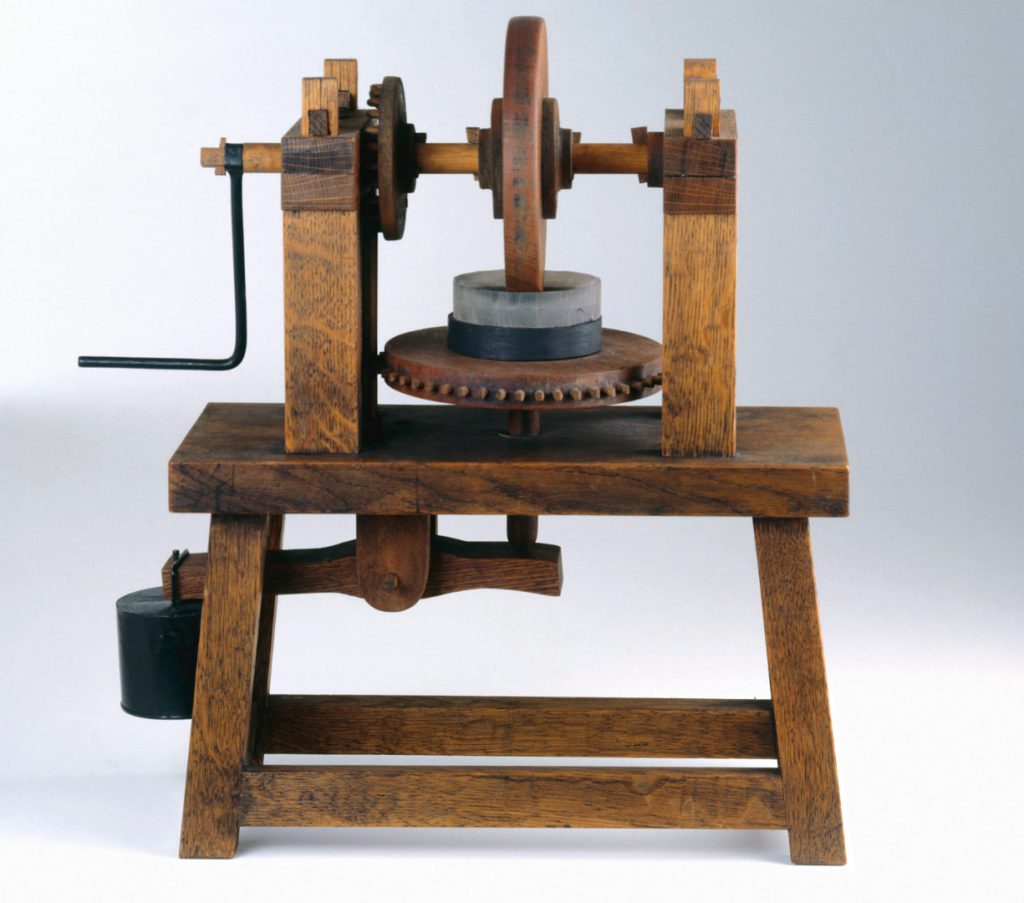
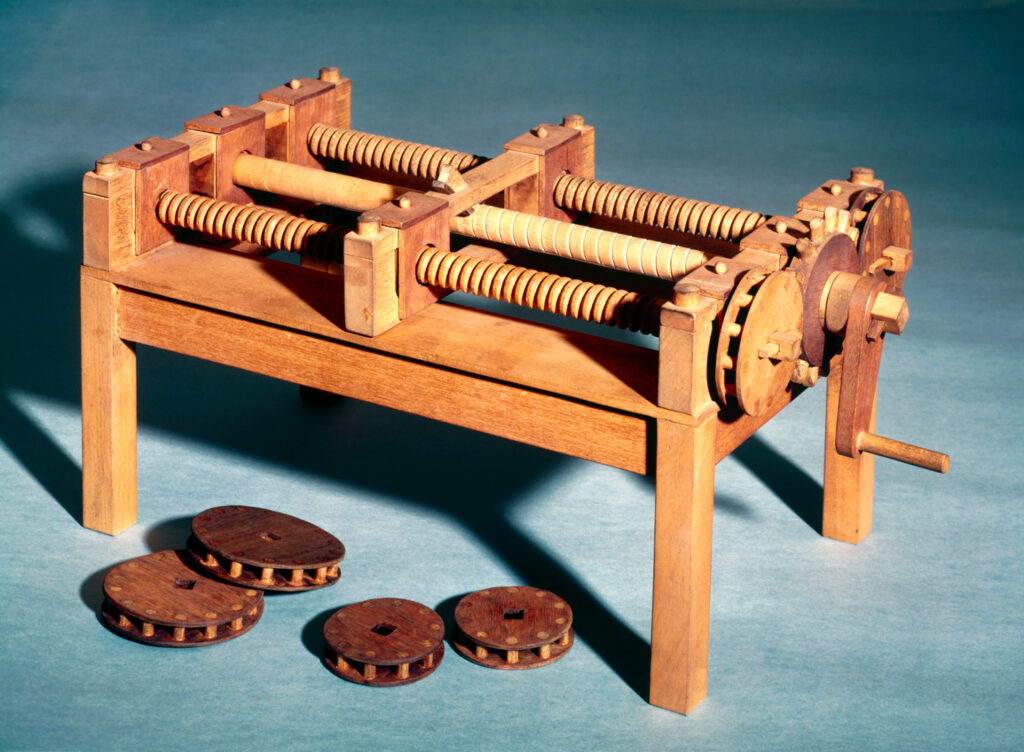
Gilbert also had charge of organising the photography of drawings that were to be included in the exhibition, where the originals could not be borrowed.[36] There was concern over what quality the Museum’s photographic studio would be able to produce, but Kelly was reassured by seeing three samples, pronouncing them ‘excellent, which relieves my mind a good deal’.[37] Gilbert made his selection of 146 photographs from facsimiles of the Atlantic Codex in Milan and of the manuscripts at the Institut de France. A few original drawings were included in the science section, including the famous ‘Child in the Womb’ from Windsor Castle (Royal Academy, p 84).
Reception and outcomes
https://dx.doi.org/10.15180/150403/006The exhibition opened on Thursday 6 March 1952 and as early as 14 March a letter to The Times suggested that the weekend crowd was ‘so tremendous’ that opening hours should be extended into the evening, to allow people to visit ‘this wonderful exhibition’ (Kenworthy, 1952). Never one to linger, Kelly replied in a letter printed the following day that public interest had been ‘so enormous’ that it had been decided to open till 8.30 pm on Tuesdays and Thursdays (Kelly, 1952). On 31 March he wrote to Sherwood Taylor that ‘The success of the Leonardo Exhibition is altogether beyond anything we had considered probable’ and he proposed an extension to 14 September, which would more than double the intended run, since the original closing date had been the end of May.[38]
There was significant press interest in the models, fulfilling Greenaway’s prediction that Leonardo would be ‘News’ in 1952. On 19 March two photographs appeared in The Times, one of them showing part of the science section display in the background (The Times, 1952). On 29 March there was a magnificent two-page spread in The Illustrated London News, with photographs of six of the models, again some of them showing the gallery, accompanied by the relevant Leonardo drawings (The Illustrated London News, 1952). Towards the end of the run Kelly wrote to Sherwood Taylor that this had been ‘one of the most successful Exhibitions we have ever given … when next you have another such idea, please don’t hesitate to let us know!’[39] The Royal Academy used the income to refurbish its antiquated heating system (Hutchinson, 1968, p 186).
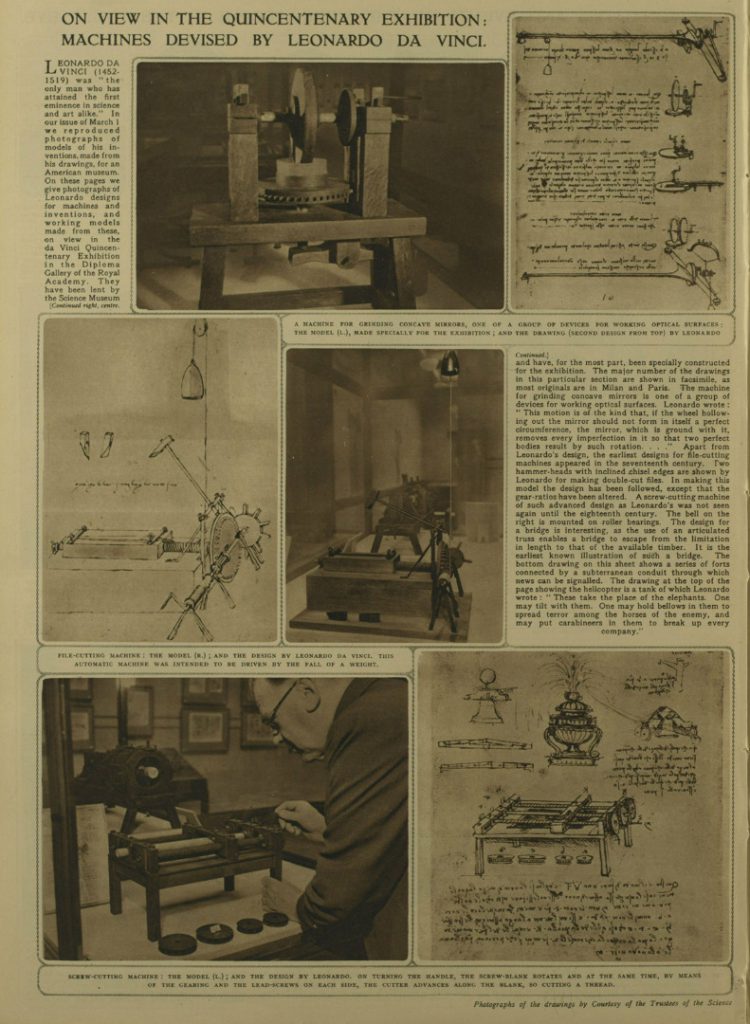
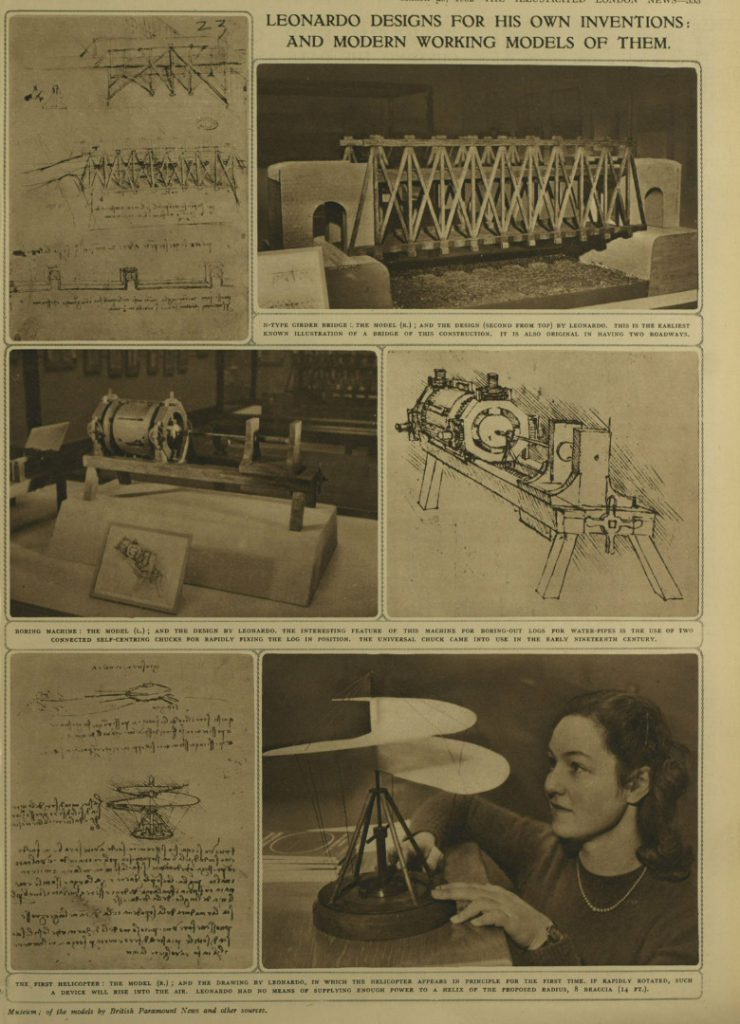
Between October 1952 and January 1953 the Science Museum arranged a touring exhibition of the models and photographs to the City Museum and Art Gallery (Department of Science and Industry) in Birmingham, the City Museum, Bristol, the Royal Scottish Museum, Edinburgh, and the Glasgow Art Gallery. Gilbert repeated his lecture in Birmingham.[40] Models appeared elsewhere in connection with the quincentenary and 56 were displayed in 1953 at the Museum of Science and Technology in Milan, having been commissioned the previous year to mark the anniversary. They are considered more accurate than those in the lost 1939 set (Landrus, 2013, p 326).
As for Sherwood Taylor, in March 1952 he had articles in The Spectator (‘Leonardo as Scientist’) and The Tablet (‘Leonardo the Humanist’). In the former he suggested that Leonardo ‘is perhaps to be thought of as scientist rather than painter’ (Sherwood Taylor, 1952a). It may reveal something about Gilbert’s choice of models, that Sherwood Taylor makes the point that not all the machines Leonardo drew were his own inventions, while a number of models in the exhibition are from designs Sherwood Taylor says were original with Leonardo. Perhaps something further is revealed in The Tablet, when Sherwood Taylor makes a distinction between machines that work beyond the power of man, such as cranes and pumps, and those that ‘accelerate and make more accurate the work of the hand’, where he detects the greater originality (Sherwood Taylor, 1952b). The same bias is evident in Gilbert’s choice of models.
Appropriate to the journal and to Sherwood Taylor’s own convictions, in The Tablet, he can offer some more Catholic sentiments than in The Spectator. He proposes a more integrated view – ‘Leonardo the scientist and Leonardo the artist were not two different people’ – but suggests that something was forfeited by his analytical focus:
Man’s view of the world was not yet differentiated into a scientific and an artistic one: it was still the whole view of the middle ages, but extended – indeed, perhaps distorted – towards natural science. If we see in Leonardo’s work a wonderful portrayal springing from an understanding of structure, we see likewise an impoverishment of the spiritual content of his work as compared with that of his fore-runners and some of his contemporaries.
Sherwood Taylor, 1952b
The Last Supper is a wonderful portrayal of character and emotion, but lacks any sense of ‘unique sacramental significance’ (Sherwood Taylor, 1952b).
Sherwood Taylor was invited by Alexandre Koyré, expenses paid, to speak at an international congress on Leonardo and science, to be held in Paris in 1952. Among his professional peers, he returned to his core interests and offered to speak on chemistry in the early sixteenth century, though he would pronounce in The Spectator that ‘the only scientific subject on which he [Leonardo] seems to have been incurious was chemistry’[41] (Sherwood Taylor, 1953).
The models in 2016
https://dx.doi.org/10.15180/150403/007All the models from the 1952 exhibition survive in the Science Museum today, as do many of the photographic prints and most of the negatives (though deterioration with age has meant that some have been remade).[42] Some of the models will once again go on public display to accompany the travelling exhibition ‘Leonardo da Vinci: the Mechanics of Genius’, that will open at the Science Museum in February 2016. This exhibition is itself built around forty of the models first displayed in Milan in 1953. Both sets of models were influential early instances of what has become a major strand in exhibitions on Leonardo.
The incoming exhibition has a modern display idiom, with interactive demonstrations and video installations in a spacious presentation of large panels and images. In a series of major international venues, it has to meet the expectations of today’s visitors. There is no original material but there is a thoughtful agenda and a narrative to support it; this is not an uncritical presentation of Leonardo as a wizard inventor. It seeks to dispel misunderstandings and to encourage thoughtful reflection on the character of Leonardo’s genius. Two critical points are established at the beginning: not all the drawings of machines should be thought of as ‘inventions’ and, in producing such drawings, Leonardo was part of a technical culture with many participants. Distinct sections on aspects of Leonardo’s work then contribute to a concluding notion of ‘unifying knowledge’: Leonardo’s technical resources and talents were used to support his natural inclination to draw together insights and techniques from disciplines that most of his contemporaries would have treated as distinct. A thoughtful exhibition based around what are presented as ‘historical models’, supplemented by the slightly earlier examples from the Science Museum, will create an opportunity to think about the part model-making has played in shaping the popular appreciation of Leonardo.
Historians and philosophers of science have been interested in the role that physical models in general have played in discovery, explanation and learning (Hesse, 1963; Morgan and Morrison, 1999; Chadarevian and Hopwood, 2004). How do they function in the scientific discourse – only by analogy, or as candidate accounts of reality, however partial? Other historians have used close reproductions of instruments or have carefully reworked experiments as techniques for recovering knowledge and skill not recorded from the original instances (Sibum, 1995). The Leonardo models, however, are different; they sit outside any of these discussions and projects. They represent nothing that existed in Leonardo’s time and his drawings do not contain enough information to build them without assumption and interpretation. Perhaps their value to the discipline of history is that they enforce very detailed examination of the drawings, which can yield new insights. Beyond this, the building of models is a response to different imperatives: those of the museum gallery and exhibition. Stories such as this one are needed if we are to understand how models have become so conspicuous in the public appreciation of Leonardo.
We can see concerns from the early days of modelling, in Britain at least, in the archives of the Science Museum. Accuracy was to be prioritised over spectacle: the drawings were to be the principal guides, not the large models of 1939. There was concern also that Leonardo himself may not have made any models or had plans for full-scale machines, and visitors should not be misled into assuming otherwise. There was a realisation, as there would naturally be in the Science Museum, that single-viewpoint perspective drawings were an inadequate guide and that much would have to be assumed or embellished in the process of designing and building the models. Accuracy was bound to be compromised.
What we do not find in the early record is anxiety over whether model-making might run counter to the spirit as well as the factual record of Leonardo’s work. Over sixty years later, we might ask whether the present ubiquity and familiarity of models is affecting how we view Leonardo’s project of, as the exhibition puts it, ‘universal knowledge’? Sherwood Taylor was scarcely alone in seeing a shared sensibility across the range of subjects for Leonardo’s drawings, natural as well as artificial, pointing to ‘…his attempt to find common elements in the working of very different parts of the world, human, organic and inorganic’ (Sherwood Taylor, 1952b). There can be little doubt that models have helped create the current appetite for Leonardo exhibitions, but the historical perspective of the incoming example, especially at the Science Museum, where the British story began, can be an occasion for reflection on where this trend might lead. If we make drawing for Leonardo, at least in the case of his machines, principally a matter of ‘designing’ (in the modern sense), might we compromise our appreciation of his drawing as a tool of understanding and knowing? (Galluzzi, 1996, pp 46–85, 187–239; Kemp, 2006, pp 62–77)
Acknowledgments
I am grateful for help from colleagues in Oxford, Matthew Landrus and Tony Simcock, and at the Science Museum, Rory Cook, David Exton and John Liffen.
Tags
Footnotes
Back to text
Back to text
Back to text
Back to text
Back to text
Back to text
Back to text
Back to text
Back to text
Back to text
Back to text
Back to text
Back to text
Back to text
Back to text
Back to text
Back to text
Back to text
Back to text
Back to text
Back to text
Back to text
Back to text
Back to text
Back to text
Back to text
Back to text
Back to text
Back to text
Back to text
Back to text
Back to text
Back to text
Back to text
Back to text
Back to text
Back to text
Back to text
Back to text
Back to text
Back to text
Back to text



